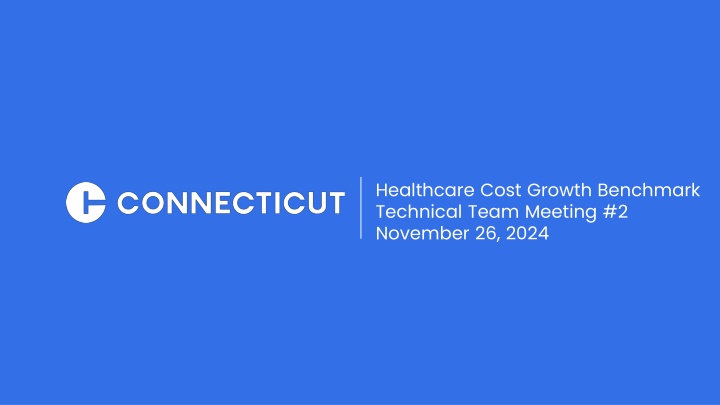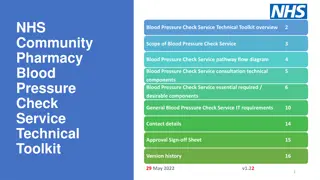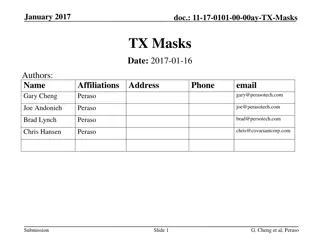
Healthcare Cost Growth Benchmark Technical Team Meeting Insights
Explore the insights from the Healthcare Cost Growth Benchmark Technical Team meetings, covering topics like total healthcare expenditure measurement, setting cost growth benchmarks, decision-making criteria, and more. Review meeting recaps, action items, and comparative cost growth rates to understand trends and performance in healthcare spending.
Download Presentation

Please find below an Image/Link to download the presentation.
The content on the website is provided AS IS for your information and personal use only. It may not be sold, licensed, or shared on other websites without obtaining consent from the author. If you encounter any issues during the download, it is possible that the publisher has removed the file from their server.
You are allowed to download the files provided on this website for personal or commercial use, subject to the condition that they are used lawfully. All files are the property of their respective owners.
The content on the website is provided AS IS for your information and personal use only. It may not be sold, licensed, or shared on other websites without obtaining consent from the author.
E N D
Presentation Transcript
Healthcare Cost Growth Benchmark Technical Team Meeting #2 November 26, 2024
Meeting Agenda Time Topic 2:00 p.m. I. 2:05 p.m. II. Meeting 1 Recap 2:15 p.m. III. Healthcare Cost Growth Benchmark A. Review of current total healthcare expenditure (THCE) measurement methodology B. Methodology for setting the 2026-2030 healthcare cost growth benchmarks i. Decision-making criteria for the economic indicator on which the benchmark will be based ii. Review of other states methodologies and values iii. Review list of indicator options in Connecticut, e.g., gross state product, potential gross state product, median income, average wage (without discussion of a value for the benchmark) iv. Historical and/or forecasted trends for indicators 3:55 p.m. VII. Wrap-Up, Next Steps, and Public Comment 4:00 p.m. VIII. Adjournment Welcome Healthcare Cost Growth Benchmarks and Performance To Date
Technical Team Meeting #1 Recap During the first meeting, OHS reviewed the charge and objectives of the Technical Team and presented a plan for achieving them. We also reviewed background information about healthcare cost growth benchmarks and primary care spending targets in Connecticut and other states, including Connecticut s legislation and governance structure Spending performance to date in Connecticut and in other states Equity considerations in benchmark programs Technical Team Meeting #1 Recap
Meeting #1 Recap: Action Items OHS sent the following additional information to the Technical Team in response to requests and discussion; OHS s October report to the General Assembly, which includes legislative recommendations for meeting healthcare spending benchmarks. Reports and data on primary care spending OHS also compiled information showing comparative state cost growth rates and per capita cost in response to the meeting discussion. The next few slides display the average cost growth rate from 2019-2022 by state, alongside the 2022 PMPY spending. This is shown for the statewide THCE and by market. Meeting #1 Recap: Action Items
Comparative Cost Growth Rates and Per Capita Costs: Statewide THCE The average cost growth rate for 2019-2022 is shown along the x-axis, in ascending order. The y-axis represents 2022 per member per year (PMPY) costs. Comparative Cost Growth Rates and Per Capita Costs: Statewide THCE
Comparative Cost Growth Rates and Per Capita Costs: Commercial Market Comparative Cost Growth Rates and Per Capita Costs: Commercial Market
Comparative Cost Growth Rates and Per Capita Costs: Medicaid Market Connecticut is the only state of those shown that does not have Medicaid managed care. Comparative Cost Growth Rates and Per Capita Costs: Medicaid Market
Comparative Cost Growth Rates and Per Capita Costs: Medicare Market Comparative Cost Growth Rates and Per Capita Costs: Medicare Market
A. Review of current total healthcare expenditure (THCE) measurement methodology
Current Total Healthcare Expenditure Measurement Methodology: Review 1. Defining total healthcare expenditures (THCE) 2. Determining whose total healthcare expenditures are being measured 3. Measuring total medical expenses (TME) 4. Levels of reporting spending relative to the healthcare cost growth benchmark Current Total Healthcare Expenditure Measurement Methodology: Review
1. Defining Total Healthcare Expenditures Healthcare benchmark programs provide a comprehensive view of healthcare spending for their residents, across public and private payers. Total Health Care Expenditures (THCE) Total Medical Expense (TME) Net Cost of Private Health Insurance (NCPHI) All claims-based spending paid to providers by public and private payers, and net of pharmacy rebates All cost-sharing paid by members, including but not limited to co- payments, deductibles and co-insurance* The measure used to assess entities performance against the cost growth benchmark The costs to state residents associated with the administration of private health insurance All nonclaims payments to providers 1. Defining Total Healthcare Expenditures
Patient Cost-Sharing Payers report the allowed amount on a claim, which includes a) the amount paid by the insurer to the provider and b) the patient s financial obligation to the provider. It is the maximum allowed charge for a covered benefit. It includes the portion the patient owes the provider according to the patient s benefit plan. It does not capture whether the patient actually paid what was owed. Patient Cost-Sharing
Spending That is Not Included in THCE (1 of 2) 1. Patient out-of-pocket spending on non-covered services For example, non-medical cosmetic surgery and non-health care services-related discounts offered by an insurer (e.g., gym membership). 2. Spending by people who are not insured We lack a means to capture all payments made by individuals who are uninsured. While there are some point-in-time research estimates and survey data, there is no comprehensive data source to capture out-of-pocket spending by the uninsured. Similarly, there is no comprehensive data source on what insured consumers pay for non-covered services. THCE spending is typically calculated using payer-submitted data. Spending That is Not Included in THCE (1 of 2)
Spending That is Not Included in THCE (2 of 2) 3. Uncompensated care Provision of care at no charge or at discounted rates ( charity care ) and care for which no payment was received for services provided ( bad debt and write-offs) are not part of THCE. If bad debt is related to covered services for which the payer made a payment, it will be captured because the OHS is measuring payer allowed amounts. Uncompensated care represents a provider cost, not payer or patient spending. Spending That is Not Included in THCE (2 of 2)
2. Determining Whose Total Healthcare Expenditures Are Being Measured THCE includes spending on behalf of Connecticut residents who: have health insurance coverage through Medicare, Medicaid, commercial carriers (fully-insured and self-insured), Veterans Health Administration, or state correctional facilities, and receive care from any provider in or outside of Connecticut.* When calculating statewide per capita spending, OHS uses the covered lives figures reported by payers. *Spending for out-of-state residents receiving care from in-state providers is excluded from THCE. 2. Determining Whose Total Healthcare Expenditures Are Being Measured
3. Measuring Total Medical Expenses (TME) Measuring spending growth of total medical expenses (TME) of Advanced Networks requires attribution or assignment of individuals to primary care providers and understanding of provider affiliation with Advanced Networks All healthcare spending on behalf of a member, regardless of where the services were received or by whom they were performed, are attributed to the member s primary care provider. Primary care providers are attributed to the entity by which the provider is employed or with which it is otherwise affiliated. 3. Measuring Total Medical Expenses (TME)
4. Levels of Reporting Spending Relative to the Healthcare Cost Growth Benchmark During the next meeting, we will discuss whether OHS should report Advanced Network spending growth overall (i.e., across all markets) or by market, as is current practice. Advanced Networks (Provider Entities) 4. Levels of Reporting Spending Relative to the Healthcare Cost Growth Benchmark
B. Methodology for setting the 2026- 2030 healthcare cost growth benchmarks
Methodology for setting the 2026-2030 healthcare cost growth benchmark(s) We will now turn to discussion of setting the annual healthcare cost growth benchmarks for CYs 2026-2030. To facilitate this process, we will: 1. Establish decision-making criteria for the indicator(s) on which the benchmark will be based 2. Review other states methodologies and values 3. Discuss indicator options in Connecticut (without discussion of a value for the benchmark) 4. Consider whether to use historical or forecasted trends for indicators Methodology for setting the 2026-2030 healthcare cost growth benchmark(s)
Decision-making criteria for the economic indicator on which the benchmark will be based OHS adopted decision-making criteria to guide selection of economic indicators to set the 2021-2025 benchmark values. Why economic indicators? OHS sought an objective basis for the benchmark values. It was following the precedent set by the states that had previously established cost growth benchmarks (MA, DE, RI). Decision-making criteria for the economic indicator on which the benchmark will be based
Decision-making criteria for the indicator(s) on which the benchmark will be based OHS established that the indicators must: 1. provide a stable and therefore predictable target; 2. rely on independent, objective sources with transparent calculations; and 3. result in a benchmark value that lowers growth in healthcare spending for consumers, employers, and taxpayers. Do these criteria resonate with you? Are there other criteria OHS should consider? Decision-making criteria for the indicator(s) on which the benchmark will be based
Review of other states methodologies and values Before we get into discussion of the indicator options for the 2026-2030 benchmarks, let s review methodologies in use by other states. Eight states have adopted healthcare cost growth benchmarks to date. Between 2018 and 2022, states established target values ranging from 2.9 percent to 3.8 percent. Target values were roughly 2 percentage points less than the average annual state healthcare spending growth over the prior decade in each state. Review of other states methodologies and values
Review of other states methodologies and values All states have tied their targets to some measure of the economy, including state economic growth and/or indicators of resident income growth. As we observed last meeting, Connecticut places the highest weight of all states on a consumer-centric measure (median household income). Each state reviewed several different indicators and considered the following questions: What does the indicator measure and is this relevant to the charge? What is the state signaling if it ties future healthcare spending growth to a particular indicator? States also considered prior spending growth in their state commercial, Medicaid, and Medicare markets. Review of other states methodologies and values
State Benchmarks and Methodologies (1 of 2) Benchmark Methodology Benchmark Value State Average annual rate of change in historical median household income from 2002-2022. Add-on factors: +0.5% for CY 2025-2026, +0.2% for CY 2027-2028, +0.0% for CY2029 3.5% for 2025-2026 3.2% for 2027-2028 3.0% for 2029 California 3.4% for 2021 3.2% for 2022 2.9% for 2023 4.0% for 2024* 2.9% for 2025 3.8% for 2019 3.5% for 2020 3.25% for 2021 3.0% for 2022-2024 3.6% for 2013-2017 3.1% for 2018-2022 3.6% for 2023-2025 80/20 blend of median household income and PGSP Add-on factors: +0.5% for CY 2021, +0.3% for CY2022, +0.0% for CY 2023-2025 Connecticut PGSP Add-on factors: +0.25% for 2021, +0.0% for CY2022-2023 Delaware 2013-2017: PGSP 2018-2022: PGSP (3.6% in 2018) minus 0.5% 2023 and beyond: default rate of PGSP, per statute Massachusetts *Modified from 2.9% to account for inflation State Benchmarks and Methodologies (1 of 2)
State Benchmarks and Methodologies (2 of 2) State Benchmark Methodology Benchmark Value 3.5% for 2023 3.2% for 2024 3.0% for 2025 2.8% for 2026-2027 3.2% for 2019-2022 6.0% for 2023 5.1% for 2024 3.6% for 2025 75/25 blend of median projected household income and PGSP Add-on factors: +0.3% for 2023, +0.0% for 2024, -0.2% for 2025, -0.4% for CY2026-2027 New Jersey PGSP for 2019-2022. 75/25 blend of PGSP and forecasted median household income growth for 2023-2027. Accounted for the lagged impact of inflation on health care costs by adjusting the PGSP inflation input with inflation experience on a two- year lagged basis for 2023-2025. Non-formulaic consideration of: historical GSP; historical median wage; CMS waiver & legislative growth caps applied to the state s Medicaid and publicly purchased programs Rhode Island 3.4% for 2021-2025 3.0% for 2026 Oregon 3.2% for 2022-2023 3.0% for 2024-2025 2.8% for 2026 70/30 blend of historical median wage and PGSP, with a downward adjustment starting in 2024 Washington State Benchmarks and Methodologies (2 of 2)
Indicator options for Connecticuts benchmarks (1 of 2) We have four economic indicators to share as possible options to inform the value of the 2025-2030 cost growth benchmarks. You are invited to suggest others. 1. Connecticut s Gross State Product (GSP) 2. Connecticut s Potential Gross State Product (PGSP) 3. Median household income of Connecticut residents 4. Average wage of Connecticut workers We will describe: What the indicator measures and represents. What the message would be if the benchmark target was set to the indicator being considered. Indicator options for Connecticut s benchmarks (1 of 2)
Indicator Options for Connecticuts benchmarks (2 of 2) Today we will discuss the options for the indicators without a discussion of the values they would produce. During our next meeting, we will present modeling of indicators, based on the feedback and preferences expressed today. We will display values for each indicator of interest. We will whether there is a rationale for adjusting the benchmark value produced by the indicator(s) of interest, and if so, the manner in which the benchmark value could be adjusted. Note: OHS statute requires legislative Insurance Committee approval if the average future benchmark value is more than .5% above or below the average benchmark value for 2021-25. That value is currently 3.3%. Indicator Options for Connecticut benchmarks (2 of 2)
Option 1: Connecticuts Gross State Product (GSP) Gross State Product (GSP) is the total value of goods produced and services provided in a state during a defined period. GSP is often considered the main measure and key target of economic policy at all levels of government. The growth in GSP tells us how fast the state s economy is growing. This is the state counterpart to Gross Domestic Product (GDP), which is measured at the national level, with a few methodological differences in how the figures are calculated. By tying the benchmark to GSP, we would create an expectation that healthcare spending should not grow faster than the economy. Connecticut s Gross State Product (GSP)
Option 2: Connecticuts Potential Gross State Product (PGSP) Potential Gross State Product (GSP) measures the projected long-run average growth rate of a state economy, excluding fluctuations that may occur due to the business cycle. PGSP shows us what state economic growth is likely to be in the future. It is designed to be a stable benchmarking figure. It is used by many cost growth benchmark states. It differs from GSP in that it is a forecasted measure of the economy and takes into account anticipated labor force productivity and participation, and inflation. By tying the benchmark to PGSP, we would create an expectation that healthcare spending should not grow faster than the state economy is forecasted to grow. Connecticut s Potential Gross State Product (PGSP)
How GSP and PGSP Measures Differ Potential Labor Force Productivity Labor Income Gross Domestic Product by State Potential Gross State Product Inflation Business Taxes Potential Labor Force Growth Capital Income Population Growth How GSP and PGSP Measures Differ
Option 3: Median household income of Connecticut residents Household income is the sum of all payments received by individuals age 15+ in a household, even if unrelated. Sources of household income include wages, salaries, investment returns, income from estates and trusts, property income, retirement accounts, public assistance, child support or alimony. It is the most comprehensive measure of total income as it includes all sources income (not just wages). Median household income represents the financial health of all households in the state and is a good measure of a typical income level for the state. By tying the benchmark to median household income growth, we would create an expectation that healthcare spending should not grow faster than household income. Median household income of Connecticut residents
Option 4: Average wage of Connecticut workers Wage growth measures the change in compensation individuals receive for work as an employee or a contractor with an employer. It does not capture income such as capital gains, dividends, rent, or interest. Wage growth does not explicitly factor in inflation, although historical wage growth will reflect its impact. Wage may be a more tangible indicator for most individuals than household income as it more closely represents take-home pay. Setting the cost growth benchmark to the growth of Connecticut residents wage growth implies that healthcare should not grow faster than take- home pay of Connecticut residents. Average wage of Connecticut workers
Additional Consideration and Three Big Questions Some Connecticut hospitals have asserted that the future cost growth benchmark value(s) should factor in the costs of delivering care. Should provider costs be a consideration when determining the benchmark value? Why or why not? Are there other indicators OHS should consider? Why? To which indicator(s) should OHS tie the 2026-2030 healthcare cost growth benchmark? Why? Additional Considerations and Discussion
Economic Indicators: Historical and Forecasted Experience There are differences in economic indicators calculated using historical actual data vs. forecasts. Historical Experience Historical data reflects, to varying degrees, the volatility of year-over-year changes, including booms and busts, e.g., the effects of the pandemic and its aftermath. Historical figures are relatively easy mathematical calculations (straight average growth over prior time periods). Anomalous events can be addressed through smoothing or by extending the period, but determining the appropriate time period is not always obvious; the decision can have substantive impact. Forecasts Forecasted data are designed to be predictable, stable figures and are often calculated by government agencies and private firms. The figures and methods of calculation vary. Private forecast methodologies are not available for scrutiny and can vary by the philosophy and outlook of the chief economists at each organization. They often prove to be inaccurate because economies are volatile over time. Economic Indicators: Historical and Forecasted Experience
Discussion Should OHS use historical trends or forecasts? Historical Forecasted Advantages Easy to calculate. Reflects actual experience. Smooths out historical variability and provides more stability and predictability. Forecasts are predictions and may be incorrect. Forecast methodologies may be opaque. Disadvantages Highly variable, reflecting economic booms and busts. Unclear rationale for which time period to choose. Note: During our last meeting one Technical Team member observed that a portion of historical healthcare spending has been wasteful. We can discuss during our next meeting whether an adjustment should be made to the benchmark value to account for waste. No other state has made such an adjustment to date. Discussion
Wrap-Up and Next Steps The next Technical Team meeting is scheduled for December 13, 2024, from 3:00-5:00 pm EST. Wrap-Up and Next Steps






















